|

Carnival F1: a modified acorn type, Carnival is beautiful, productive, tasty and long lasting. It benefits from some curing, and does not lose its colors, they tend to intensify with maturity. The flesh was yellow and deep. The texture was very creamy (especially for an acorn), but meaty, similar to Delicata but with a fuller texture and mouth feel. It is pretty sweet and very mild. As a cold squash with no additions, we liked it better than Heart of Gold, which has a pointy heart shape rather than the flat bottom shape that Carnival displays.
Carnival is a hybrid of the sweet dumpling squash and the acorn squash. Classified as a type of acorn squash and a vegetable gourd the Carnival squash is a relatively new variety of squash and is sought after for its uniquely patterned and colored exterior. The color variance in the rind of the Carnival squash is the result of seasonal temperature variations with warmer temperatures producing Carnival squash with slightly more pronounced green stripes.
Choose carnival squash that are heavy for their size and free of blemishes or soft spots. They can be stored in a cool, dark place for up to a month. Warm temperatures tend to yield greener squash.
After the squash is picked, the green on the surface will eventually fade with time to leave only cream and orange colors.
Ethnic/Cultural Info
The Carnival squash was developed by plant breeder Ted Superak of Harris Seeds in North America. The Carnival squash was developed with the intent to improve upon the sweet dumpling squash. A newer squash to the commercial marketplace the Carnival has seen an increase in popularity in the United States as a result of food and lifestyle bloggers writing about finding it and utilizing it as a decorative gourd during holiday seasons and then happily discovering it additionally provides a flavorful eating squash.
Geography/History
The Carnival squash is produced from descendants of squashes native to Mexico and was introduced to the market in 1991. It is believed to be a hybrid cross of the sweet dumpling squash and a green acorn variety known as green table queen. Even though considered a winter crop, winter squash such as the Carnival need sunshine and warmer weather to flourish. Seeds should be planted after the last frost of the spring. Squash should be ready for harvest within eighty-five days of planting. Carnival squash plants grow in a semi-bush fashion which makes them an ideal squash for smaller growing spaces. Can be planted in your landscaping or in a very large pot.
Varieties:
Festival Squash
This winter squash combines the superior sweet-flavoured flesh of a Delicata with the shape of a blocky acorn. Skin has bright white and green markings with orange background stripes. 2 lbs fruits.
Chameleon
Non-runner, type Patidou, disease-resistant, it produces from 5 to 8 fruits per foot, 10 to 15 cm in diameter and 10 to 12 cm high, from 500 g to 1 kg.
Orange flesh, fine, firm, of excellent quality.
|
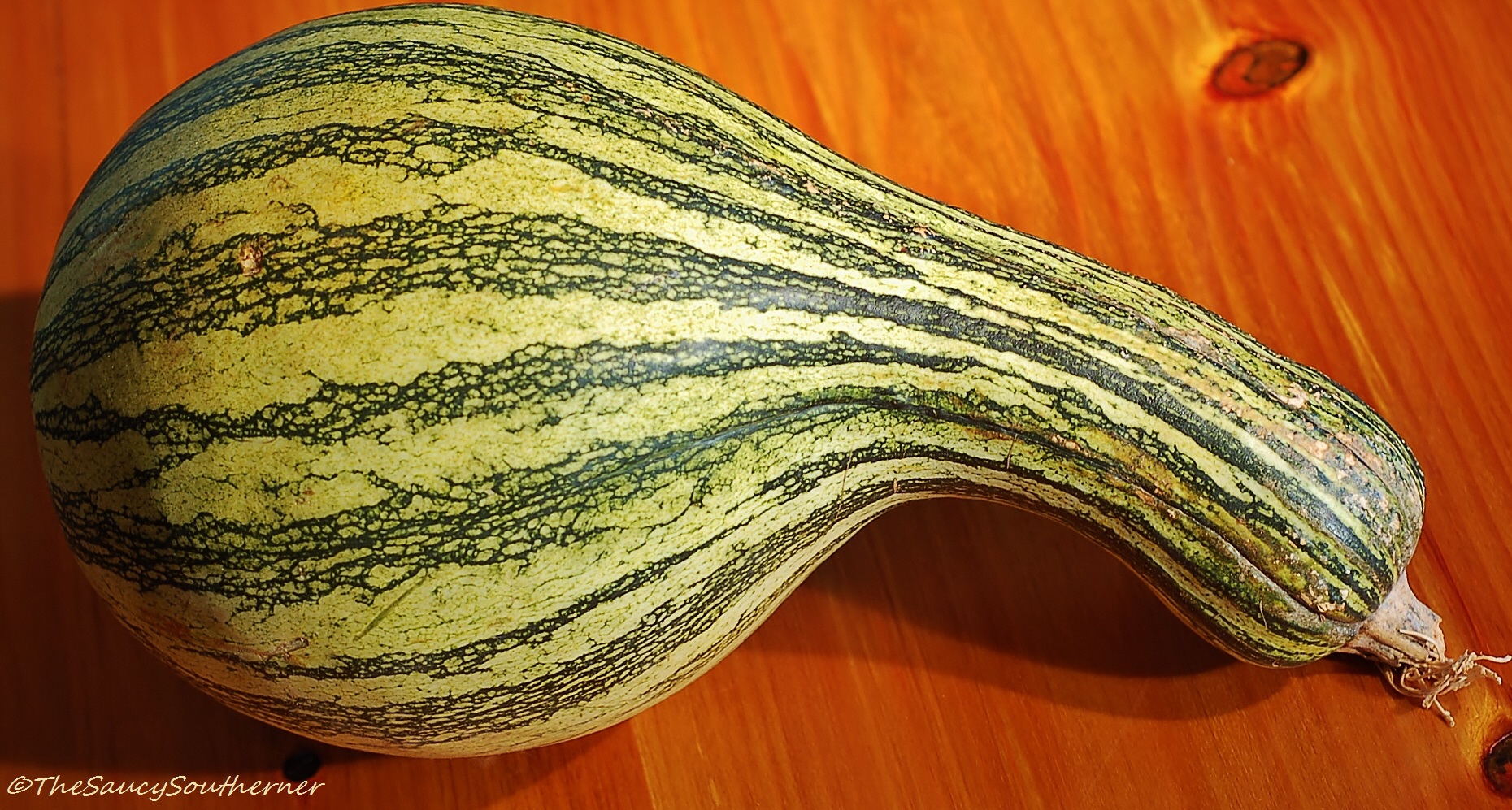
Similar to the pumpkin pie, Cushaw Pie is a Southern Appalachian tradition and is made with the Cushaw Squash. Also known as Green and Gold Cushaw.
The cushaw is grown from an heirloom seed that is sometimes known as “Tennessee Sweet Potato.” It is a prolific when grown, is resistant to vine borers, and grows well in hot, dry climates.
The look like a bowling pin and have a long neck. Some are straight, some are crooked. They come in different color combinations. Some are cream with gold stripes, others are cream with green stripes. Much of their coloring depends upon the amount of heat we get in the summer months. They have a lightly golden flesh. They are good as an ingredient, or excellent just plain with butter. We like to use them as a mashed potato substitute. They have a very refined pleasing texture, and as a bonus are a good keeper.
These are also amazing for pies. The light colored flesh has a nice texture. Many people say they are even better then pumpkin pie. It tastes very similar to pumpkin, but with it’s own distinct flavor.
Varieties:
Japanese Pie
An heirloom variety from the Land of the Rising Sun. Beautiful, 12 lb black fruit have creamy white flesh. Samuel Wilson, Mechanicsville, Pennsylvania, introduced this variety in 1884, and it quickly became popular because of its novelty and advertising. The seeds are "curiously marked or sculptured in the manner of Chinese letters." Also known as Chinese Alphabet Squash from the unique-looking seed. 105 days.
Seed reviews:
Canada Prairies: Prolific, dense flesh. Taste is not sweet.
Santo Domingo
May have originated from Santo Domingo, Dominican Republic. Tear drop shaped squash are huge, greenish with white stripes. Rare. Mature in 100-110 days. There is a great variety in shapes, colors and types of squash, making them fun to grow. Growing pumpkins can be a great project for kids. The vines need plenty of room to sprawl, although some can be supported on a trellis. Summer or winter squash or pumpkins should be sown indoors in flats in short season areas, 3-4 weeks before the night soil temperatures have warmed up. Seedlings should be gradually hardened off. Plants prefer rich, compost enriched soil. They will cross pollinate within their species. After harvest they should be ripened for 30 days in a cool location.
Tug River Cushaw
|

Also known as “Sweet Potato Squash” or “Peanut Squash”, this squash is unusually sweet, though thin-fleshed, and has deep orange, tender, and dry fine-grained flesh flavor. Oblong cylindrical fruits 5-9 inches. This very old variety was introduced in 1894 in the USA by Seedman Peter Henderson of New York. It is also known as "Bohemian" and "Ward's Individual".
Bushy plant. Fruit: Cylindrical.
Creamy white with green stripes becoming orange in the hollow of the ribs.
Fruit size: 6 to 8 cm in diameter. Length 20 cm.
Weight: 0.3 to 1kg.
Epidermis: Smooth and fine.
Flesh: Yellow, sweet, good nutty flavor.
Description / information: Variety of easy culture and fine flavor.
It offers 6 to 10 fruits per foot.
Growth: 90 days.
Allow fruits to remain on the vine until fully mature. Gather before frost, leaving part of the stem attached to the fruit. Cure in a warm area for a week to 10 days, then store. This squash is an excellent climber and is recommended for growing on a lattice or fence.
It is excellent for stuffing and baking. Prepare it as you would an Acorn and eat right out of the shell.
Varieties:
Delicata Zeppelin -
It is a selection of the Delicata variety, dating from 1894, obtained by Frank Morton in Oregon.
Honey Boat Delicata
Also known as tan delicata or sugar loaf. One of the sweetest squash varieties in existence. Oblong, Delicata-shaped squash has tan skin with green stripes. Excellent quality and produces early. Developed by Dr. James Baggett, Oregon State University.
runner: yes
fruit: creamy white, striped with fine green stripe going from the peduncle to the umbilicus.
These stripes turn orange when ripe.
fruit size: 5 to 8 cm in diameter. Length 10 to 15 cm.
weight: 0.3 to 0.8 kg.
epidermis: Smooth.
flesh: Yellow-orange and firm.
description / information: Variety that needs a lot of heat.
It offers 6 to 9 fruits of very good quality per foot.
growth: 110 to 130 days.
Jester F1
As attractive and the same size as delicata, but with better eating quality and acorn-like shape. Jester is oval, tapered at both ends, with small to average ribs. Fruits have an ivory background with green striping between the ribs, and avg. 1 1/2 lb. Widely adapted, short-vined plants average 5-7 fruits/plant. Like other acorn and Delicata type squash, best eating is within 2 months of harvest.
Baby Delicata
Candystick Delicata
A variety from Carol Deppe and Nate France bred for organic systems, Candystick is as its name implies, sweeter than traditional delicatas. The fruits are also larger. Like Thelma Sanders Sweet Potato Squash, this delicata is a repeat variety in our Michigan garden for ease of growing (we trellis it), productivity, manageable fruit size, irresistible sweetness and long-term storability. An added bonus is its thin edible skin makes peeling unnecessary. Candystick Delicata is certain to delight northern gardeners.
|
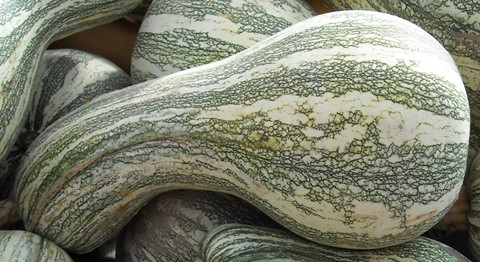
Suitable for cooking and pies.
Also, known as the Tennessee Sweet Potato.
Fruits are pear-shaped with a crookneck. Flesh is pale yellow, thick, medium coarse with the sweet Cushaw flavor. This has long been a southern favor for gardeners. The green-striped Cushaw’s large, vigorous vines are resistant to the squash vine borer, which kills other squash and pumpkin plants.
Varieties:
Batopilas Canyon
Large, bilobal to necked fruit are mostly green and white striped with somewhat thickened stems and occasional corky ribs. From the bottom of Batopilas Canyon in the Sierra Tarahumara, Mexico. But grows at low elevation in the hot deciduous forest zone.
Yoeme Kama
Also called Mexican Squash. Variable sizes, shapes and color of fruits with thick, flavorful yellow flesh. From Ures, Sonora (Mexico) at about 1500 feet elevation.
fruit: Light green striped with yellow. Pear shape. fruit size: 18 to 28 cm in diameter. Length 25 to 45 cm. weight: 4 to 10 kg. epidermis: Smooth and tender. flesh: Yellow. description / information: Variety of delicate culture. It offers 2 to 6 fruits per foot. growth: 130 to 160 days.
Chihuahua
Chihuahua is a pumpkin variety originating from Mexico. It is very popular in the north of the country and the city of Chihuahua. It's shape can vary from roundish to pear shape, but both versions have smooth green rind marked with yellow and cream. Both versions also have a thick stem which grows down over the rind and gives the appearance of lava flowing from the top. The yellow flesh is firm, medium sweet with a good flavour. The small to medium length, thin vines produce good fruit numbers in a bit over 100 days. Once mature, the rind becomes rock hard, which would make them a wonderfully long keeper.
North Falkland Island Squash
An egg-shaped squash grown for its silvery seeds. Can also be pure white or white with gold stripes. This is an amazing heirloom pumpkin variety from the North Falkland Islands. This variety produces 2 distinctly different looking fruits- The first is round to pear shape with a creamy white rind with occasional yellow marking and the second is similarly shaped with rind with greenish yellow markings. Amazingly, both fruit have virtually the same flesh-light yellow colour, fairly thick, firm, dryish, mild but tasty flavour. The medium size vines produce fruit ranging from 1kg to 2kg in 100 days. Whilst the vines can be grown together and will successfully cross pollinate, each vine will produce fruit all the same colour, not some of each colour.
Chimayo Calabaza
Cushaw type fruit without a large neck originally from Chimayo, New Mexico. Vines produce green and white striped winter squash that turns orange when mature. A winter squash, but great as a summer squash, and has loads of edible flowers and seeds.
Seed review:
Utah, United States- This one has grown tremendously here with hot days and cool nights. It is productive, vigorous, and the immature fruits are tasty as summer squash. It has perhaps the largest running vines I've ever seen. There are more squash than with other cushaws (except one - North Faulkland Island, which is not edible). I've used it as a summer squash and have used the flowers. Will update the mature taste and seeds. Well I never ate the seeds or the mature flesh - let the fruits rot. Mature fruits were large - to 20 inches in diameter, and probably 20 lbs (they have large seed cavities). I suspect the mature flesh is not that sweet, and it was pale yellow, not orange, but the texture seemed good. Lots and lots of seeds, and likely good to eat, and one of the reasons this variety is cultivated. These are long keepers too. And very ornamental with striking colors - yellow, white, and green.
Cushaw Green Striped Squash
C. mixta (110 days) Aka 'Tennessee Sweet Potato'. This ancient Native American squash has a storied history. Growing to 10-20 lbs and 18" long, its fruit is bulbous and white with green stripes. The meaty flesh is slightly sweet and the fruit store extremely well - up to four months. It was a staple among the First Nations people of the southwestern U.S. and they passed it on to settlers. Even today, it is a favourite for making pies and "cushaw butter". This is a very hardy plant, tolerating high heat and resistant to the squash vine borer.
Hindu Squash
A large pear-shaped squash, white with green stripes. The flesh is yellow and very mild-tasting. The plants are productive, yielding several fruits each when grown well. 110 days.
|
|
Hilo Laotian seems to be a unique landrace that may have originated In Laos. In 2010 Joe was in the remote area of Northern Laos and he collected fruits at a jungle market with his daughter Alicia, It was 4.00 a.m. because the farmers try to sell their products so that they can get to the fields by daybreak. Joe found the present squash at a stall in Hilo Hawaii; an older Asiatic gentleman barely speaking English) was selling these squash. With the little that Joe could find out, it was a pure strain that was from Asia.
|
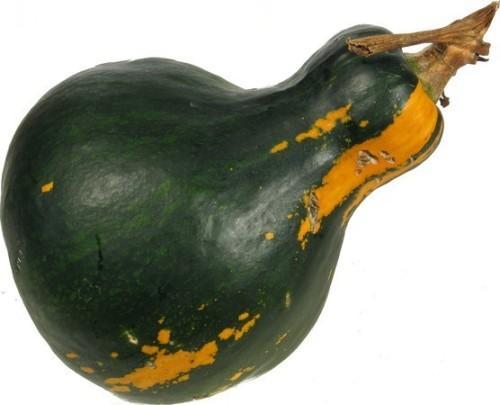
The Hopi Indians already grew these gigantic, pear-shaped fruits called Hopi Black Green squash. Very dark green with some light green stripes. Each fruit weighs ± 7kg. The yellow flesh is very popular. A good squash for warm climates. Rare variety. 110 days.
Seed Review:
Mine are green, then black, then gray when I pick them. I start mine early indoors then put them in a sunny window when I bring them inside in the fall to turn orange early so I can get seeds to sell in autumn instead of waiting until late winter, when they usually ripen if direct planted and left to age in the cellar.
Her's are a bit flatter than most of mine but that may be because mine usually grow on their side. I am always afraid I will break the stem if I turn them.
Then there are always the changes brought about by select breeding. I've been growing mine from my own seed for a few years now. I keep seed form the largest, dryest, roundest, smoothest best squash for myself to plant the following year.
The Hopi Black squash is very sweet, dense and delicious. It has a small seed cavity with a lot of meat.
The meat is a much darker orange than any squash I have seen. There's a big difference in the colour.
Varieties:
Hopi Green
Hopi Green is one of several pumpkin varieties developed and grown by the native Hopi Tribes of Arizona USA. The fruit of this variety are pear shaped (or sometimes round) with dark green smooth rind that turns yellow as they mature. They have a short, thick stem and some weighed in the range of 2kg to 4kg but heavier is possible. Inside, the yellow flesh is firm, dry and nicely sweet.
|
|
Collected in 1940 in the northeastern Iranian city of Torbat-e-Heydariyeh, and preserved at the USDA seed bank ever since. Not known to the public until a few years ago, when our friend Glenn Drowns introduced it. This squash is super ornamental, with its unique, foam-green rind that’s mottled in soft peachy orange. Round and slightly ribbed fruits are medium to large in size. It keeps for a year or more, and is perfect for fall decorating. The seeds are great for roasting.
Seed reviews:
Buckhorn, Canada - Grows Well, flesh is really thick but dosen't have much of a pumpkin taste. I found even with this long growing season it was slow to mature before first frost.
Arizona: Grows well, so-so taste, can be seasoned, lasted in storage 2 years.
MO: Grows well. The largest squash maxed-out at 37.9lbs being harvested and cured in early July.
CA: Grows well. Tastes plain.
|
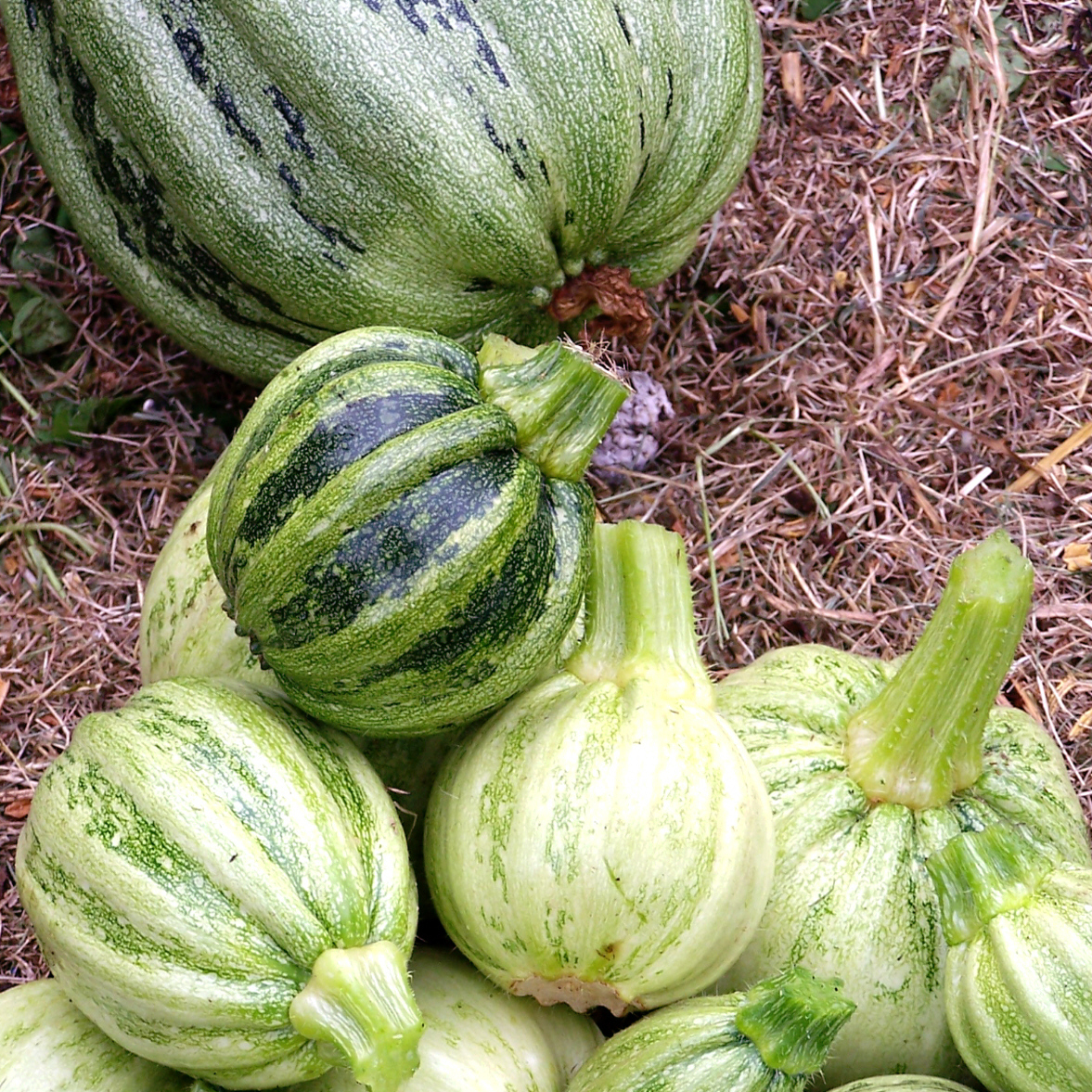
Heirloom; known as Kumi Kumi and also as 'Kamo Kamo' by Maori people. Heavily ribbed, speckled green, soft skinned fruit 20-30cm across with nutty flavour. Harvest when young for use like zucchini or marrow, or leave to mature for use like pumpkin. Trailing vine.
Varieties:
Mongogo of Guatemala
runner: yes
fruit: light green to yellow on the ribs and dark green in the hollow of the ribs.
Ribs round and well marked to the number of ten.
Round, very long peduncle.
fruit size: 15 to 20 cm in diameter.
weight: 2 to 4 kg.
flesh: White and tender.
description / information: Variety of easy culture and very good quality.
It offers 2 to 5 fruits per foot.
growth: 100 to 130 days.
Usage: Young: like zucchini.
At maturity: Decorations, raw, grated, gratins, desserts.
conservation: up to 1 year.
Piedras Verdes
Green Stone squash. origin: Central America, Mexico.
runner: yes
fruit: Dark green pear-shaped elongated.
Ribs ten rounded and marked.
fruit size: 20 to 30 cm in diameter in the swollen part. Length 25 to 55 cm.
weight: 8 to 18 kg.
epidermis: Smooth and tender.
flesh: Orange-yellow and firm.
description / information: A variety of difficult crops that need heat.
It offers 1 to 4 fruits of very good quality per foot.
growth: 130 to 160 days.
use: soup, gratins, purees, ratatouille, jam.
conservation: 4 to 8 months.
|
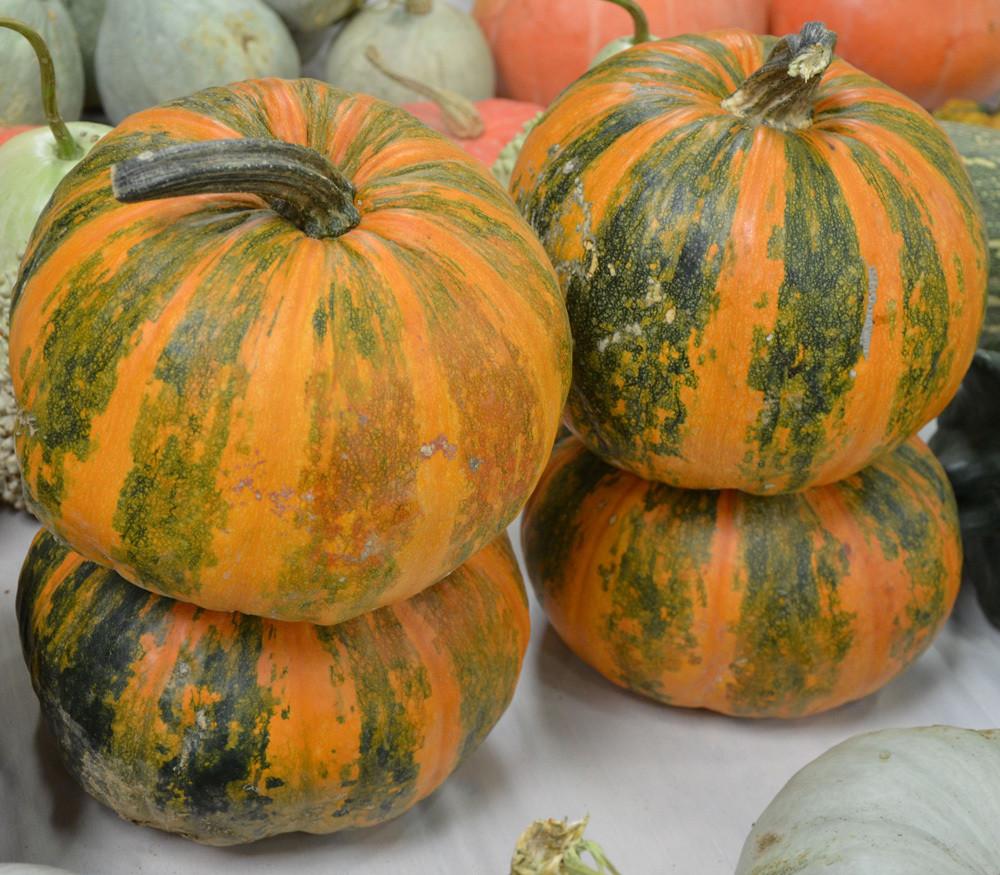
Also known as Oil squash. Lady Godiva Pumpkin was developed by Allan Stoner of the USDA Agricultural Research Service in 1972 for the hulless seeds as a snack food. He combined two other naked seed pumpkin lines for better flavor and production. The naked or hulless greenish seeds are very nutritious and rich in protein and are great roasted or raw. The pumpkins grow 4 - 8 lbs, with 12 - 15 pumpkins per plant and give about 1 lb of seed for each fruit. The flesh is not considered to be very tasty, but does work well in sweet pumpkin breads or pancake recipes.
It offers 6 to 12 fruits per foot. growth: 110 to 130 days. use: Dried seeds, raw or roasted for aperitif.
Revitalizing oil can be made from the seeds. The seeds have deworming properties. They have a beneficial effect on the prostate thanks to their wealth of zinc. conservation: 3 to 5 months.
Roasted, salted pumpkin seeds, also known as "Pepitas" are easy to make. Remove and clean the seeds, then drizzle with olive oil and roast on a cookie sheet in the oven at 150 - 200°F for 45 - 60 minutes until crunchy.
This variety was introduced in 1972 by Alan K. Stoner (USDA Agricultural Research Service). It comes from a cross between two varieties of naked seed squash "PI 267663" (developed by LC Curtis of the Connecticut Agricultural Experiment Station in the 1940s) and "Beltsville Accession 102" (marketed by Agway in 1965). She is also called "Naked Seedeed" and "Hulless".
Many gardeners will harvest the hulless varieties somewhat green, as they can be prone to sunscald. It is best to harvest the seeds fairly soon after picking - within one to two weeks - as they do have a tendency to sprout inside the pumpkin if left too long.
Varieties:
Styrian - This pumpkin was developed in the province of Styria in Austria and has been documented since 1870.
In Eastern Europe in the region of Austria, Yugoslavia and Hungary pumpkins are often used for livestock feed. The Hungarian Mammoth Pumpkins (Cucurbita maxima) could easily exceed 100 pounds. Much smaller are the Styrian Pumpkins (Cucurbita pepo) of the same region, only a few pounds, which not only fed livestock but the seeds; rich in oil, were removed to press into a dark green oil used in salads and drizzled into soups and pasta. In Stryia it is as popular as olive oil and imparts a pleasant nutty flavor. The interesting trait of the Syrian Pumpkin, sometimes called Kakai are the seeds that are naked. They lack a testa or seed coat. When snacking on pumpkin seeds, the seed coat is the white shell that has to be removed because of it's toughness. Styrian and other naked seed (or snackseed pumpkins) either partially lack the tough seed coat or in some cases, completely lack a seed coat.
Kakai - Avg. 5-8 lb. Semibush, short-vine plants. Avg. yield: 2-3 fruits/plant.
Scheherazade
Beautiful, warted, orange and green striped fruits weighing 5-10 pounds. This is a great choice for fall decorations. This was developed as an oil seed pumpkin so the seeds can be pressed to yield a dark nutty oil perfect for salad dressings or as accents in squash soups. Also, the flesh is good to eat. You can bake it like spaghetti squash because it has a similar texture. 85 days.
Junona Squash
Large, hull-less seeds, flesh great for breads and cake.
Miranda
Like Kakai, but more yellow and warty.
Yerevan Armenian
From the city of Yerevan, Armenia. Everywhere that one goes in Eastern Europe there are forms of Cucurbita pepo squash that are a little longer than they are round. A good majority of these squash originated in Austria and Hungary and are called “ Lady Godiva Pumpkins”. That is because a good percentage of them were selected for their “ naked” seeds ( hence the Lady Godiva moniker). In November 2011, Joe was on a squash collecting expedition to Armenia and Georgia. He collected what is simply called here the Yerevan Armenian Squash at one of the farmers markets in Yerevan. The seed available here was grown out by Laurel Mehl of Coral Tree Farm in Encinitas, California. The squash are large golden-orange and attractively different because of their rough and ribbed fruits. Very decorative, but also worth growing for their food value. And for “pumpkin seed lovers”, the seeds- either raw or roasted -are a delicacy.
Hamlet
Ukrainian naked seed variety. Semi-bush plant. Round flattened fruit. Average weight 2.5-4 kg. / 5.5-9 lb. Light green to white, naked seeds. High oil content. Seed yield not very high. Taste of fruit is mediocre.
Gleisdorfer Ölkurbis
Gleisdorfer Naked Seeded Pumpkin or Oil Pumpkin was developed at the Gleisdorf Seed Breeding Institute in Austria. The plant was licensed in 1969 and introduced commercially in 1970. Hybrid varieties include Gleisdorfer Express and Gleisdorfer Diamant.
Mozolevskaya
This variety originated in Russia.
Fruits: round, sometimes more or less elongate; Size (D): 25 cm; Flesh: thick, light orange, fibrous and of medium quality;
Vine behaviour: Vine; Weight: 2.5 kg - 4.0 kg
Maturity: 100 days
High-yielding, tasty, with orange pulp Mid-season variety. The vegetation period is 118-120 days. Universal use. The plant is long-pleated, the length of the main lash is 4-9 m. The fruit is oval, slightly ribbed, weighing 4-8 kg. The surface is slightly ribbed. The rind is hard, ligneous, thin, with wide, longitudinal, torn stripes in the form of spots. The pulp is orange, dense, slightly fibrous, sweet. Transportability and keeping quality average. Relatively resistant to diseases. Productivity and taste high. Recommended for cultivation in all areas of Ukraine.
|

Very good for cooking.
A unique variety, once cherished by the Lakota Sioux, and distinctly pear-shaped. The skin color is a variegated green and orange, although some fruit will be entirely orange and others entirely green. The fine-grained orange flesh has a sweet and nutty flavor. Has baking qualities similar to Hubbard squash. The crimson-orange flesh is also delicious when raw — grated in salads or slaw — but also good in chili.
Lakota is a red heirloom from the American Midwest and is also called the Red Lakota. They make for a delightful display when mixed with their Blue Lakota cousins.
Growing: This is a vining Hubbard type squash that grows to about 7-8 lbs. and will normally have 3-5 squash per plant. It does very well in Northern climates where many other squash have a hard time reaching maturity. This squash is an excellent climber and is recommended for growing on a lattice or fence.
Seed Reviews
Missouri: low yield. Great taste
California: Hardy and grows well.
Ohio: Great yield, grows well.
Texas: Large plant, grows well.
Massachussets: Grows well in the climate.
South Carolina: Low yield, low heat tolerance.
Minnesota: Prone to bugs.
California:Great grower and producer of fruit. Needs room
Utah:Grows well in hot climate.
North Michigan:Grows well, great producer.
Also Grown in Pennsylvania, Connecticut, Massachussets
|
|
Millionaire (Hybrid) Pumpkin Suitable for eating.
Fruit Type – Hybrid (Vegetable Spaghetti Squash)
Average Weight – 7 to 12 lb.
Plant Type – Semi-bush
Thick flesh cooks to a unique vegetable spaghetti product.
Fruit mature from white with green stripes to orange with gold stripes.
Excellent rock hard handles.
|
|
|
|
|
This little fellow is like a small version of a Turban. It usually has fewer lobes, and their hat is generally solid orange and not striped.
Very decorative variety, mushroom-shaped, more and more widespread in our country in recent times. It is also called mini turban, mushroom squash or Bonnet Rouge. Probably the pumpkin described as
"little Chinese turban" in the work of Vilmorin in 1885.
|
|
The stunning, round to bell-shaped fruits are terra-cotta to buff-colored, and warted very attractively. You’ll want to use this one in centerpieces and displays before you consign it to the kitchen! A commercial variety in north Africa.
Seed Reviews:
NY: Grows well. Delicious, sweet taste.
|
|
Plant produces good yields of 20" long with curved neck pumpkin. The skin is white with orange stripes. It has thick yellow flesh making it excellent for making pies. Pumpkin can weigh up to 30 lbs. 110 days. From Mexico.
|
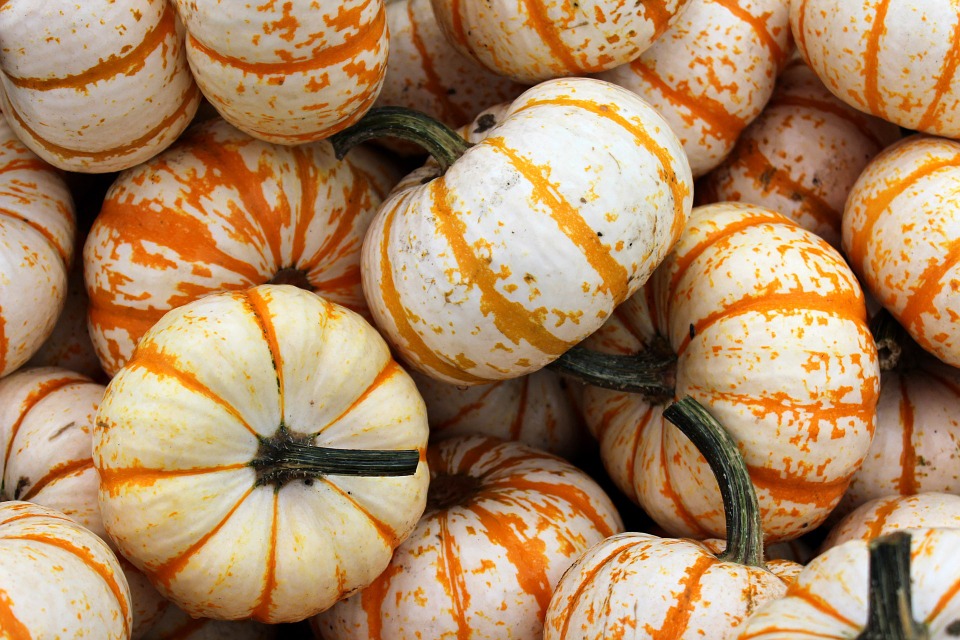
F1 Hybrid Mini pumpkin, Lil Pump-Ke-Mon Pumpkin are flattened and moderately ribbed with bone white skin and orange to green stripes.
Lil' Pump-Ke-Mon Pumpkins were developed by a Ted Superak for the Harris Moran Seed Company. Released 2000. Bigger than the in the USA bred Puccini. Plant: Bush; Fruit: flatround; Size (DxL): 10 x 5 cm; Flesh: bright yellow; Storage time: +++ Weight: 0.4 kg - 0.6 kg
Maturity: 90 days
Varieties:
Puccini F1
A pumpkin very popular in Japan.
Mini Tiger pumpkin
Measuring six to eight inches in diameter Mini Tiger pumpkins have a classic yet squat pumpkin shape.
Mandan
Mandan or Yellow Mandan squash was introduced commercially in 1912 by the seed firm of Oscar H. Will & Company of Bismark, North Dakota. That strain was white, oblate in shape, and yielded fruit weighing 3 to 4 pounds on plants generally described as “bush,” even though they sent out vines of considerable length. In any case, the squash was said to originate among the Mandan Indians of the northern Great Plains, hence the name. In fact, Mandan appears to be a variant form of several similar North American squashes of great age. No one has effectively pinpointed their true origin.
The white-skinned Mandan of Will & Company became a well-known commercial variety, more round in shape than the yellow variety that I grow. Its creamy skin is dappled with deep forest green between green stripes. The flesh is a pale lime-white and makes an excellent summer squash when harvested young.
The authors of The Vegetables of New York: The Cucurbits (1937, 201) remarked that White Mandan was similar to two old Eastern squashes: Long Island White Bush, and Green Striped Bergen, the latter introduced commercially in 1841. Because of its bell-like shape, I have always assumed that my Yellow Mandan is actually a selection of Green Striped Bergen by another name. There are several reasons to support this, nineteenth-century iconographic sources aside.
The Yellow Mandan is not a yellow White Mandan. The flesh of the yellow is either pale orange or golden yellow (depending on soil), and the skin is a creamy yellow where the white is “sea foam white,” an old term for white with a tinge of green. Furthermore, the fruits of the yellow are smaller, weighing 1 1/2 to 2 pounds, or just about half of what one would expect of a true White Mandan. The yellow is also more fragrant when ripe and stores better. It can be pared, seeded, sliced like an apple, and dried.
Varietal distinctions aside, only Mandan and Yellow Mandan are presently available through Seed Savers Exchange; the others have vanished from seed lists altogether. It is an excellent squash for small gardens. The leaves resemble large grape leaves, and they hug the ground so that the vines do not compete with taller vegetables nearby. Thus, it thrives under the protection of corn or around the base of staked tomatoes. More important, the plants produce abundantly. I am sure that I have gathered at least fifteen squash from each hill, and this during the height of a drought that in my region wiped out the Jersey pumpkin harvest.
I dry this pumpkin in order to reconstitute it as paste or puree for my ongoing recipe project in American Indian cookery. Frankly, dried pumpkin is practical, since it stores easily and does not take up much space. Otherwise, treat the mature fruit like acorn squash. Incidentally, the young fruit, when about 2 inches in diameter, may be sliced and served raw with dips or cooked like the small Ronde de Nice zucchini.
|
|
Native American heirloom. Round or pear-shaped white fruit with mottled green stripes producing large, tasty ‘silver-edged‘ seeds. Grown mainly for its seeds which are easily removed when roasted. The seeds are then, salted & used as pepitas. The flesh cn be used in dishes, though tastes different from other winter squash. Also called Pipian From Tuxpan.
Varieties:
Vera Cruz Pepita
Some say Vera Cruz Pepita's fruits are even prettier and their seeds are more remarkable than "Pepita". Vera Cruz Pepita is a pretty field cultivar from Veracruz in southern Mexico. Grown for the long, narrow seeds, which are toasted for snacks or ground to prepare Pipian sauces. Plant: climbing; Fruit shape: white / green striped, flat round; Fruit size (D): 20 cm; Flesh: whitish; Recommended use: for steaming , decoration. Storage time: +++ Weight: 3.0 kg Ripening time: 115 days
|
|
Suitable for cooking and pies.
Hybrid of Kobacha(buttercup type). Yellow-orange, thick, and dense, dry flesh. Oblate shape with shallow ribbing. Avg. 3-6 lb. Avg. 8 fruits/plant. Hybrid of 2 other squash.
|

A round, mini-sized winter squash with a deeply indented stem area. It's skin is white or yellow, with green jagged stripes. It is very sweet in flavor with tender light orange flesh. Called "Patidou" by the French.
A "Dumpling" type squash. DumplingAbout Dumpling Squash
Squashes of Cucurbita pepo, acorn group were domesticated by Native Americans then later made their way to Europe and Asia. The Dumpling variety specifically was first developed in 1976 by Sakata Seed Corporation of Yokohama, Japan. At the time it was a popular practice in Japanese squash breeding to take larger popular American squash varieties and breed them to be smaller in size and more home garden and home chef friendly. Dumpling squash grow on shorter trailing vines and will benefit from being trellised in order to keep fruits off the ground. Expect plants to produce between eight and ten petite squash within ninety and one hundred days of planting. Squash will be ready when stripes are green, and their stems start to crack. The plants will thrive best in frost free, sunny climates and prefer a rich well-drained soil and moderate moisture.
Varieties:
Harlequin
A highly attractive green, gold and yellow striped acorn / dumpling squash. Exceptionally sweet flesh. F1 Hybrid.
|
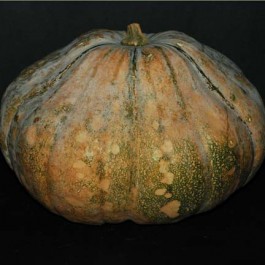
Noob Taub is a 6-8 lb spotted fruits start out grey-green, turning yellowish when ripe. Shapes vary from a round, slightly flattened pumpkin to a more unusual bottle shape. Flesh is very thick, grading from intense orange nearest the skin to very pale in the interior. Flesh not particularly sweet; our grower recommends it for savory recipes rather than dessert uses. Originated among the Laotian Hmong people.
Varieties:
Palav Kadu
Palav Kadu is an heirloom pumpkin variety from the area that encompasses Tajikistan and Uzbekistan. The fruit is cylindrical and flattened on both ends with a smooth rind that starts out green with cream spots and changes to a dull buff-orange colour as it matures. The medium size vine is a great producer of fruit up 3kg but around 1.5kg is the norm, in a speedy 85 days. Flesh is a strong yellow colour, firm, dry and sweet with fine flavour. The seeds are all in the bottom part of the fruit, which means the top part is all flesh. It can store up to 6 months. In the Tajik language, the name translates as "squash for palav" which is a very well known local dish. 100 days.
|
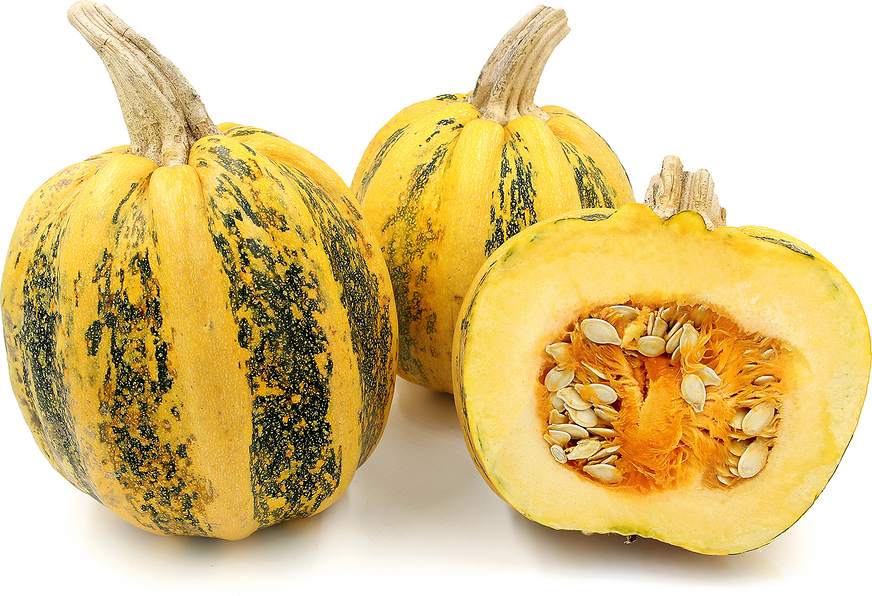
Description/Taste
The American Tonda is a small to medium-sized winter squash with a classic pumpkin-like shape. The rind has a dark green background with light green and orange-yellow mottling and alternating grey and green stripes along wide ridges. As the squash matures, the coloring will take on an increasingly yellow and orange hue. When cooked the inner flesh is dry, orange in color and offers a sweet squash flavor similar to that of butternut squash.
An Italian winter squash variety of the American Tonda squash is also known as Tonda Padana and Americana Tonda squash. Ornamental types such as the American Tonda were popular in the mid-nineteenth century and recently have been making a comeback. Known for its ornamental attributes as much as for its use in cookery, the American Tonda is a specialty squash and can be found at select farmers markets and specialty stores when in season.
It has a dry sweet flesh which was traditionally used for gnocchi.
Ethnic/Cultural Info
Believed to be an Italian variety the American Tonda also known as Tonda Padana gets its name from the Italian word for round (tonda) and from the Po or Padania Valley, the north-western region where the squash is believed to have originated. The American Tonda squash is very similar in appearance and may be a relative of the New Zealand squash popularly used by the Maori known as kumi kumi or kamo kamo squash.
Its name,” American” is thought to have been given from the squashes appearance in shape to the classic American pumpkin.
Varieties:
Tarahumara Pumpkin
Pumpkin-shaped medium sized fruits are cream, pale and dark green, yellow, and orange in color. Most have striped skin but some solid colors present. Sweet pale to dark orange flesh, great tasting. Abundant seeds great for roasting.
Mongogo Du Guatemala
An exotic heirloom squash from Guatemala, with four pound, pumpkin-like fruits that are striped green and yellow. When mature the fruits can be used for baking and when young can be cooked like a summer squash.
Southern Miner
Bred in Brazil for its meaty seeds.
Guicoy
These squat little fruits are amazing! Gorgeously ribbed in the alternating high-low ribbing seen in other Central American squashes, the warted, flattened fruits appear in tones ranging from green to deep yellow. This ancient variety is depicted in late Mayan pottery and was featured on a major Maya archeology website. Used as a winter squash, weights tend to top out just under 2 lbs, perfect for a small family. May also be used as a summer squash. 100 days.
Tabergmouzt
Squash from Morocco named "Tabergmouzt", it can grow up to 5 Kg.
|
|
(aka Citrouille de Touraine, French Tours) An historic French field pumpkin, named for its place of origin, and listed by Vilmorin as early as 1856. Large-fruited (17 pounds), with distinctive large oil seeds with wide margins which were once used in the manufacture of sugar-coated pills and as a remedy for tapeworm. Great for displays and carving. 90-100 days.
|
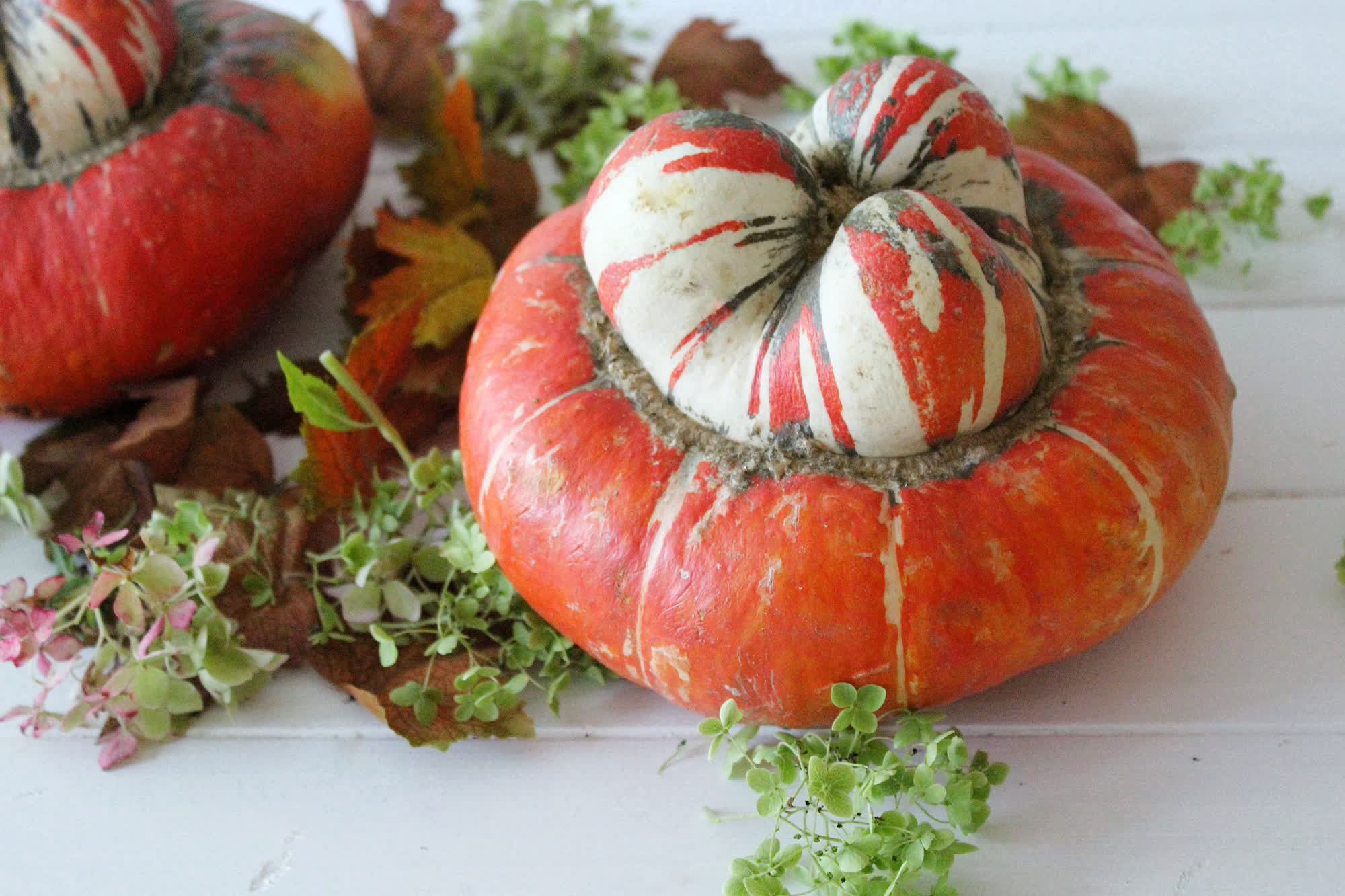
Suitable for cooking
An old time favorite for traditional fall decorating. The red color will deepen as the fall progresses. It can be eaten and is terrific stuffed with meat loaf. Sadly today it's cooking qualities are overlooked and it is most often used as a decorative gourd.
Has fine-textured orange flesh can vary from mild to sweet depending upon variety.
Commonly known types are Turk’s Turban, French Turban, American Turban, and Marina di Chioggia.
The Turban squash is first mentioned in the 1818 publication of Le Bon Jardinier. A variety known as the French Turban is said to predate 1820, its flavor was bland and texture watery, so it was predominantly used as an ornamental. This French Turban, however, would go on to be parent along with the hubbard, acorn, and autumnal marrow to the American Turban which offered a much more desirable flavor and texture. Turban squash grows on vines which can reach eight to ten feet in length. Squash tend to be ready for harvest within 115 days of planting and should be harvested before the first hard frost of the season.
Very old variety mentioned in the book "vegetables" of Vilmorin-Andrieux (1885) and also called "Giraumon Turban".
Varieties:
Aladdin's Turban
One of the most colourful of the turban squash.
White Turban
A pure white selection found as sport in a multiplication, selected for some years to a pure strain. Typical shape and size of Turks Turban with a diameter of 25 cm. Keep dark at maturity to prevent color turning to yellowish or greyish.
Giraumon Turban
French variety with a turban shape, less decorative than Turban Turk, but more interesting in the kitchen. The pulp is of fine texture and does not soften too much with cooking.
Suitable for cooking at Wok.
|
|
|
 MBZ
MBZ
